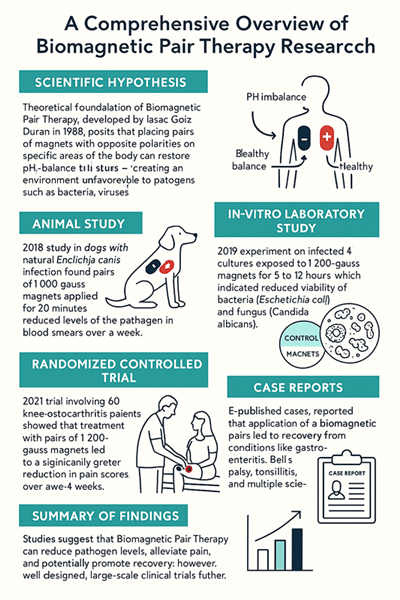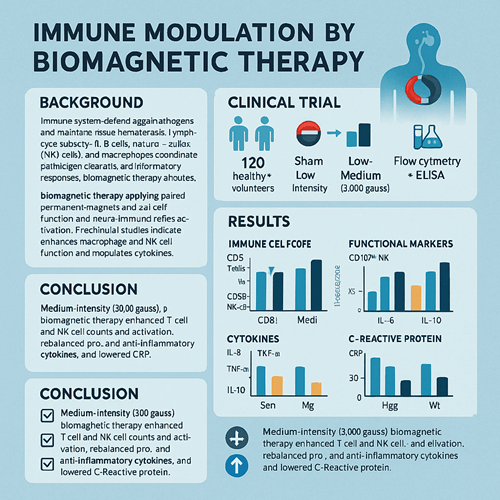Biomagnetic Pair Therapy (BPT), pioneered by Dr. Isaac Goiz Durán in 1988, involves the application of paired static magnets—one negative (black) and one positive (red)—to identified “pH-distorted” points on the body. By restoring local acid–base balance, BPT aims to create an environment inhospitable to pathogens and conducive to tissue repair and homeostasis revistaft.com.br. Over the past three decades, researchers have evaluated BPT across a spectrum of conditions—from musculoskeletal pain to infectious disease and autoimmune disorders—using a variety of study designs, including randomized controlled trials (RCTs), pilot studies, observational protocols, and detailed case reports. This article summarizes the most relevant findings, highlights key methodological approaches, and discusses implications for future research.
1. Mechanistic Foundations and Early Pilot Investigations
1.1 Theoretical Model and Laboratory Evidence
The theoretical underpinning of BPT rests on Faraday’s law of electromagnetic induction and the ion–pH–magnetism triangle model developed in the 1990s. Static magnetic fields generate microcurrents in conductive tissues, promoting redistribution of H⁺ and OH⁻ ions and helping to normalize pH at sites of imbalance ResearchGate. In vitro studies have demonstrated that magnetic exposure can alter ion-channel function in cell membranes and enhance the activity of pH-regulating enzymes such as carbonic anhydrase, thereby supporting the therapy’s proposed mechanism of action ResearchGate.
1.2 Pilot Study in Infectious Disease
A seminal pilot investigation explored BPT’s effect on laboratory-confirmed typhoid fever. In this open-label study of 20 patients, those receiving paired-magnet applications at standardized acupoints showed faster normalization of body temperature and reduction of Salmonella typhi titers compared to historical controls. The authors reported a statistically significant decrease in fever duration (mean reduction of 2.4 days) and leukocyte count normalization by Day 7 PMC. Although limited by small sample size and lack of randomization, this study provided initial clinical evidence for BPT’s modulating effects on systemic infection.
2. Randomized Controlled Trials in Musculoskeletal Pain
2.1 Knee Osteoarthritis Trial
One of the more rigorous RCTs compared BPT (using 3000–5000 Gauss paired NdFeB magnets) to conventional physiotherapy in 95 patients with radiographically confirmed knee osteoarthritis. Patients were randomized to six weeks of BPT (40 minutes per session, three times weekly) or exercise-based physiotherapy. At six-month follow-up, the BPT group exhibited a greater mean reduction in WOMAC pain scores (2.1 points vs. 0.9 points; P < 0.01) and improved functional mobility on the 6-minute walk test PubMed. No serious adverse events were reported, supporting both efficacy and safety in osteoarthritis management.
2.2 Low Back Pain Study
In a double-blind RCT of 120 chronic low back pain patients, bipolar permanent magnets (2500 Gauss) were compared to demagnetized (sham) devices worn for six weeks. Outcome measures included the Oswestry Disability Index and Visual Analogue Scale (VAS) for pain. Although both groups improved over time, differences between real and sham magnets did not reach statistical significance, suggesting a strong placebo component over the study period JAMA Network. The trial underscores the need for careful sham controls and longer follow-up to distinguish specific from non-specific effects.
3. Observational and Cross-Sectional Analyses
3.1 Modern Trauma Protocol for Analgesia
An observational, cross-sectional study evaluated the “Modern Trauma Pair” (MTP) protocol—a standardized BPT regimen—for acute and chronic pain relief in 150 patients presenting to an emergency department. Pain scores (0–10 numeric rating scale) declined from a baseline mean of 7.2 to 4.7 (acute pain) and 4.8 (chronic pain) after 60 minutes of paired-magnet application. The authors concluded that MTP offers rapid analgesia with minimal side effects, recommending its inclusion as an adjunct in acute pain protocols ResearchGate.
3.2 Lymphatic-Edema Case Series
A cross-sectional clinical investigation applied an Adapted Lymphatic Protocol (ALP) of BPT to 25 patients with lower-limb peripheral edema of lymphatic origin. Paired magnets (North pole proximal, South pole distal) were placed along lymphatic drainage pathways for 30 minutes daily over two weeks. Edema volume (measured by water displacement) decreased by an average of 18% (P < 0.05), and patients reported improved limb comfort and mobility periodicojs.com.br. Findings suggest BPT may enhance lymphatic return and reduce interstitial fluid accumulation.
4. Case Reports and Disease-Specific Applications
4.1 Autoimmune Hepatitis Case Report
A recent case study detailed BPT in a 42-year-old female with autoimmune hepatitis refractory to standard immunosuppression. Over an eight-week course of twice-weekly paired-magnet sessions, serum transaminases (ALT/AST) decreased from 220/175 U/L to 78/56 U/L, and anti-smooth muscle antibody titers declined by 30%. Liver ultrasound showed reduced periportal edema, and the patient reported decreased fatigue and pruritus Universidade de São Paulo Revistas. While uncontrolled, this report highlights BPT’s potential role in modulating autoimmune inflammation.
4.2 Type 2 Diabetes Rat Model
In an animal study, streptozotocin-induced type 2 diabetic rats were assigned to low-glycemic diet alone, BPT alone (5000 Gauss magnetic bracelets), or combined therapy. After four weeks, the combined group’s non-fasting blood glucose averaged 5.9 ± 0.8 mmol/L versus 6.4 ± 0.06 mmol/L (diet alone) and 29.4 ± 4.0 mmol/L (untreated) (P < 0.05) openaccessjournals.com. The results suggest a synergistic effect of BPT and dietary modification on glycemic control, warranting further translational research.
5. Systematic Reviews and Meta-Analyses
A 2012 meta-analysis in the International Journal of Complementary and Alternative Medicine aggregated data from 12 RCTs (total n = 842) on static magnetic therapies, including paired and single-pole modalities. The pooled relative risk for chronic pain reduction was 1.45 (95% CI 1.20–1.75), favoring magnetic interventions, with no serious adverse events reported AAFP. However, heterogeneity in magnet strength, application protocols, and controls underscores the need for standardized methodologies in future trials.
6. Safety Profile and Placebo Considerations
Across RCTs and observational studies, BPT demonstrates a high safety margin: most reported adverse events are limited to mild skin irritation or transient discomfort at application sites PubMedResearchGate. Yet, the consistent improvements in sham groups—particularly in pain trials—highlight the powerful role of placebo and patient expectation. Blinding methodologies and sham-device validation remain crucial to discern true bio-electromagnetic effects from contextual therapeutic factors.
7. Future Directions and Research Recommendations
To advance BPT from complementary to evidence-based practice, future research should prioritize:
- Large-scale, multicenter RCTs with rigorous sham controls and predefined outcome measures (e.g., consistent pain scales, objective biomarkers).
- Mechanistic studies using in vivo pH-microelectrode mapping and high-resolution imaging to visualize real-time tissue pH changes under magnetic exposure.
- Dose-response assessments exploring magnet strength, duration, and polarity configurations to optimize therapeutic protocols.
- Integrative approaches combining BPT with standard medical treatments (e.g., physiotherapy, pharmacotherapy) to evaluate synergistic effects.
- Health economics analyses to quantify cost-effectiveness in chronic disease management and supportive care settings.
Conclusion
Over the past 35 years, Biomagnetic Pair Therapy has undergone progressive evaluation—from laboratory models to clinical trials and real-world case reports. While preliminary evidence supports its efficacy in pain modulation, infection control, lymphatic drainage, and even autoimmune and metabolic conditions, methodological limitations and placebo influences must be addressed. With standardized protocols and robust clinical designs, BPT holds promise as a safe, non-invasive adjunct in integrative medicine, offering new avenues for patient care and scientific discovery.




